英语语言学语用学共46页文档
- 格式:ppt
- 大小:4.59 MB
- 文档页数:46
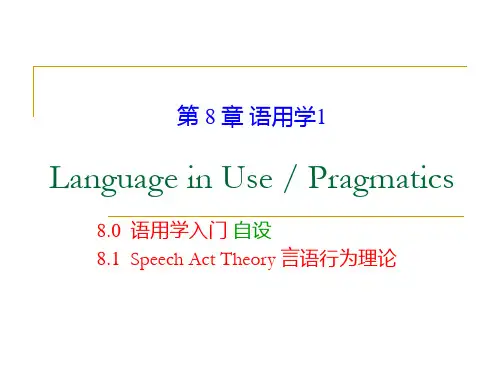
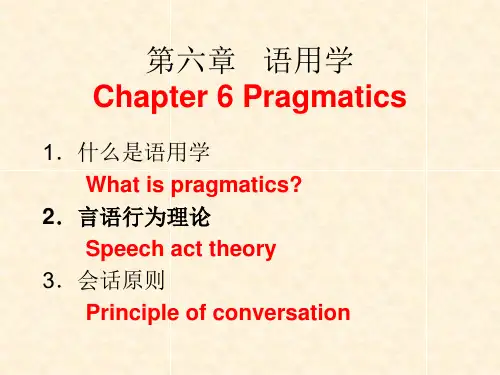
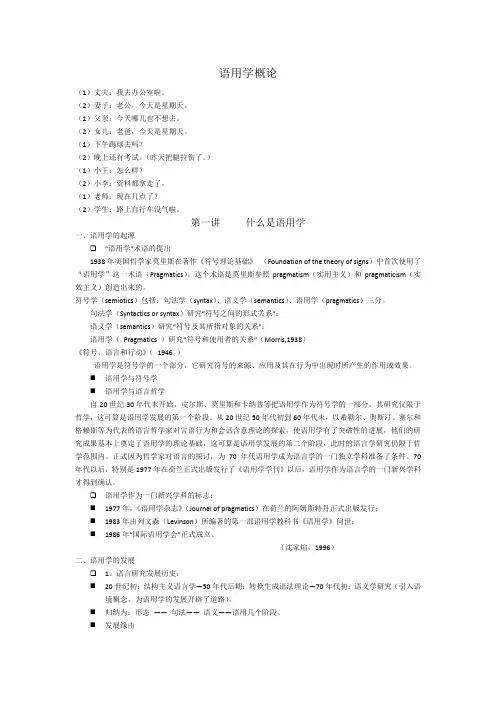
语用学概论(1)丈夫:我去办公室啦。
(2)妻子:老公,今天是星期天。
(1)父亲:今天哪儿也不想去。
(2)女儿:老爸,今天是星期天。
(1)下午踢球去吗?(2)晚上还有考试。
(昨天把腿拉伤了。
)(1)小王:怎么样?(2)小李:资料都拿走了。
(1)老师:现在几点了?(2)学生:路上自行车没气啦。
第一讲什么是语用学一、语用学的起源❑“语用学”术语的提出1938年美国哲学家莫里斯在著作《符号理论基础》(Foundation of the theory of signs)中首次使用了“语用学”这一术语(Pragmatics)。
这个术语是莫里斯参照pragmatism(实用主义)和pragmaticism(实效主义)创造出来的。
符号学(semiotics)包括:句法学(syntax)、语义学(semantics)、语用学(pragmatics)三分。
句法学(Syntactics or syntax)研究“符号之间的形式关系”;语义学(semantics)研究“符号及其所指对象的关系”;语用学(Pragmatics )研究“符号和使用者的关系”(Morris,1938)《符号、语言和行动》(1946 )语用学是符号学的一个部分,它研究符号的来源、应用及其在行为中出现时所产生的作用或效果。
⏹语用学与符号学⏹语用学与语言哲学自20世纪30年代末开始,皮尔斯、莫里斯和卡纳普等把语用学作为符号学的一部分,其研究仅限于哲学,这可算是语用学发展的第一个阶段。
从20世纪50年代初到60年代末,以希勒尔、奥斯汀、塞尔和格赖斯等为代表的语言哲学家对言语行为和会话含意理论的探索,使语用学有了突破性的进展,他们的研究成果基本上奠定了语用学的理论基础,这可算是语用学发展的第二个阶段,此时的语言学研究仍限于哲学范围内。
正式因为哲学家对语言的探讨,为70年代语用学成为语言学的一门独立学科准备了条件。
70年代以后,特别是1977年在荷兰正式出版发行了《语用学学刊》以后,语用学作为语言学的一门新兴学科才得到确认。
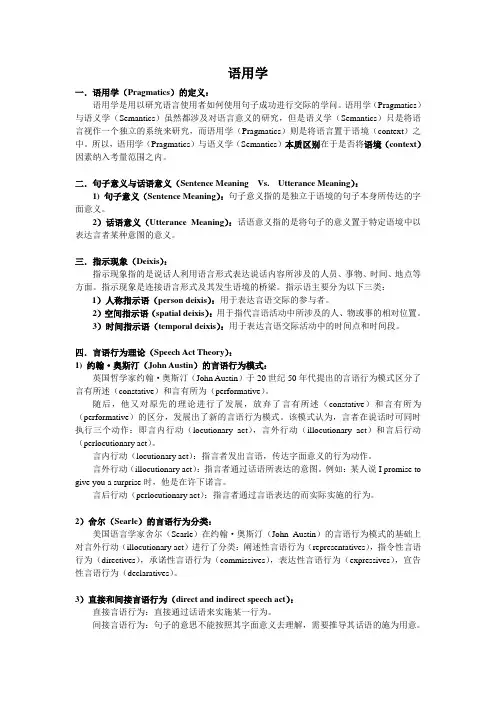
语用学一.语用学(Pragmatics)的定义:语用学是用以研究语言使用者如何使用句子成功进行交际的学问。
语用学(Pragmatics)与语义学(Semantics)虽然都涉及对语言意义的研究,但是语义学(Semantics)只是将语言视作一个独立的系统来研究,而语用学(Pragmatics)则是将语言置于语境(context)之中。
所以,语用学(Pragmatics)与语义学(Semantics)本质区别在于是否将语境(context)因素纳入考量范围之内。
二.句子意义与话语意义(Sentence Meaning Vs. Utterance Meaning):1) 句子意义(Sentence Meaning):句子意义指的是独立于语境的句子本身所传达的字面意义。
2)话语意义(Utterance Meaning):话语意义指的是将句子的意义置于特定语境中以表达言者某种意图的意义。
三.指示现象(Deixis):指示现象指的是说话人利用语言形式表达说话内容所涉及的人员、事物、时间、地点等方面。
指示现象是连接语言形式及其发生语境的桥梁。
指示语主要分为以下三类:1)人称指示语(person deixis):用于表达言语交际的参与者。
2)空间指示语(spatial deixis):用于指代言语活动中所涉及的人、物或事的相对位置。
3)时间指示语(temporal deixis):用于表达言语交际活动中的时间点和时间段。
四.言语行为理论(Speech Act Theory):1) 约翰·奥斯汀(John Austin)的言语行为模式:英国哲学家约翰·奥斯汀(John Austin)于20世纪50年代提出的言语行为模式区分了言有所述(constative)和言有所为(performative)。
随后,他又对原先的理论进行了发展,放弃了言有所述(constative)和言有所为(performative)的区分,发展出了新的言语行为模式。

语⽤学英语语⾔与⽂化A班刘⾦球2009010341361、Definitions for the Following terms:(5×3ˊ)1)Indirect speech acts: can be defined as the kind of speech acts in which one illocutionary actis performed indirectly by way of performing another. An indirect speech act can be seen as consisting of a primary illocutionary act (indirect force) and a secondary illocutionary act (literal force)2)Natural meaning: we understand that if x means p. x entails or denotes p3)Presupposition: semantic presupposition is another kind of semantic relation that linguistsare interested in. It refers to the semantic relation between two propositions of which one is the premise or pre-condition of the other.Pragmatics presupposition covers everything that the speaker assumes to be in existence or true prior to making an utterance. It concerns not only actual information but also expectations, desires, claims, fears and beliefs.4)Presequences: When we make a request, send an invitation, or announce some news, wesometimes refrain from doing it immediately. Rather, we may use one turn or two to pave the way. After this initial exchange has been concluded, we may decide whether to proceed with the request, invitation, or announcement. The sequences resulting from the preliminary exchange are called presequences.5)Negative face: the basic claim to territories, personal preserves, rights to non-interference_—i.e. to the freedom of action and freedom from imposition2、Judge Whether Each of the Following Statement Is True or False.(10×2ˊ)1)All speech acts comply with the five types of felicity conditions. F2)Grace proposed that the Cooperative Principle of conversation may consist of fivecategories . F3)Other consider the maxim of quantity is too inclusive, while the maxim of manner is toovague. T4)In all normal cases, the hearer is assumed to be the center of a speech event. F5)Semantic entailment is explicitly communicated whereas semantic presupposition isimplicitly conveyed. F6)The turn-taking system of conversation makes it unnecessary for people to overlap witheach other in conversation. F7)Face can be threatened but not saved. F8)Relevance Theory proposed by Dan Sperber and Deidre Wilson in the 1980s purports todescribe and explain linguistic communication from a cognitive point of view. T9)Communication is impossible even when encoding decoding is imperfect. F10)Background knowledge must be shared in order to conduct successful communication.F3、Answer in Short.(3×15ˊ)1)、Implicatures are “the property of utterances, not of sentences and therefore the same words carry different Implicatures on different occasions”(Thomas,1995:80). Compare thedifferent situations in which A1-B1, A2-B2 and A3-B3 take place respectively:a. A1: Your mother is a doctor. What about your father?B1: He is a lawyer.b. A2: I’ve got some trouble with my contract with the bank. Can your father help me?B2: He is a lawyer.c. A3: Your dog is serious ill. Can you ask your father for help?B3: He is a lawyer.Ask:(1) What does B implicate in b and c?(2) Can you think of one more context in which B, by saying the same thing, (He is a lawyer.) may convey some other implicature?Answer:(1)B implicate in b :My father is a lawyer. He can help you deal with this kind of problems. B implicate in c: He can not, because he is a lawyer instead of a pet doctor.(2) d: A4:The speaker is so great, can you father deliver such a speech?B4: He is a lawyer.2)、What is Lawrence Horn’s two competing forces?Answer: Lawrence Horn’s two competing forces include:a. the force of unification, or speaker’s economy;b. the force of diversification, or auditor’s economy.3)、What’s the relationship between the Cognitive Effects and the Processing Effects of relevance?Answer: the relationship of the Cognitive Effects and the Processing Effects is the more/stronger the cognitive effects, the greater the relevance (given the same amount of processing effort) and the less processing effort, the greater the relevance (given the same cognitive effects).4、Discuss Topic(1×20ˊ)Unlike Static Conversation Analysis which works on the description of conversational structure and exchange system, pragmatics can provide a dynamic perspective on conversation, touching upon such issues as the motives and strategies beneath people’s conversational behavior. For instance, when approaching pre-sequences in a dynamic manner, we are concerned with why they are used, how they advance the speaker’s conversational goal, and what outcome they bring forth. Use an example of pre-sequence to develop a dynamic analysis.Answer: The following exemplify the corresponding types of presequences:A.pre-invitationA: Say, what are you doing?B: Well, we’re going out. Why?A: Shall we go out for a walk?B.Pre-requestA: Are you free this afternoon?B: Yes.A: Can you help me with my computer? It has gone wrong again.C.Pre-announcementA: Oh, guess what?B: What?A: John won a big prize!Presequences are independent of the act-oriented sequence structure and are often composed of a question-answer pair. Their main function is to make sure, from the point of the addressee, that the request or invitation to be made is feasible, or the news to be announced is worthy of attention..。


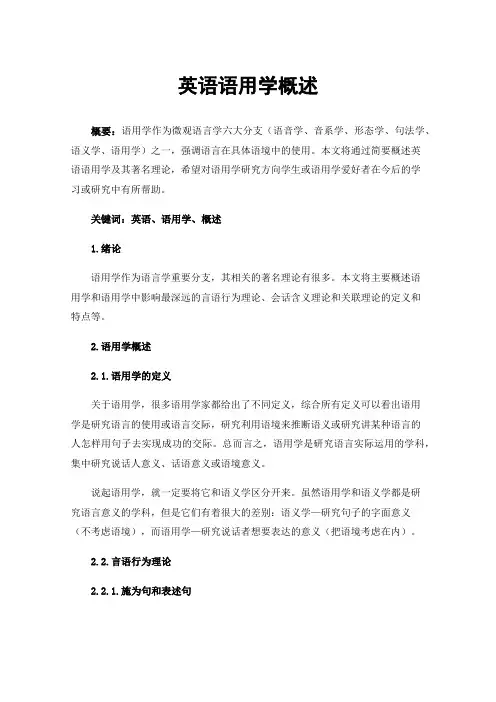
英语语用学概述概要:语用学作为微观语言学六大分支(语音学、音系学、形态学、句法学、语义学、语用学)之一,强调语言在具体语境中的使用。
本文将通过简要概述英语语用学及其著名理论,希望对语用学研究方向学生或语用学爱好者在今后的学习或研究中有所帮助。
关键词:英语、语用学、概述1.绪论语用学作为语言学重要分支,其相关的著名理论有很多。
本文将主要概述语用学和语用学中影响最深远的言语行为理论、会话含义理论和关联理论的定义和特点等。
2.语用学概述2.1.语用学的定义关于语用学,很多语用学家都给出了不同定义,综合所有定义可以看出语用学是研究语言的使用或语言交际,研究利用语境来推断语义或研究讲某种语言的人怎样用句子去实现成功的交际。
总而言之,语用学是研究语言实际运用的学科,集中研究说话人意义、话语意义或语境意义。
说起语用学,就一定要将它和语义学区分开来。
虽然语用学和语义学都是研究语言意义的学科,但是它们有着很大的差别:语义学—研究句子的字面意义(不考虑语境),而语用学—研究说话者想要表达的意义(把语境考虑在内)。
2.2.言语行为理论2.2.1.施为句和表述句言语行为理论最早是由英国哲学家约翰・奥斯订二十世纪五十年代在他的«如何以言行事»一文中提出的,是对语言交流性质的哲学阐释。
这个理论认为,我们说话的同时是在实施某种行为,其目的在于回答“用语言干什么”这个问题。
奥斯汀的首要主张是这一理论有两种句子形式:施为句和表述句。
像“I name this ship the Queen Elizabeth(我将这艘船命名为伊丽莎白号)”这样的句子我们称之为施为句。
它们不描写事物,没有真假。
说出这样的句子就被认为是实施一种行为,因此像name这样的动词,我们叫做“施为动词”。
与施为句相反,像“I pour some liquid into the tube(我往试管里倒一些液体)”这样的句子是对说话人正在做的事情的描写。
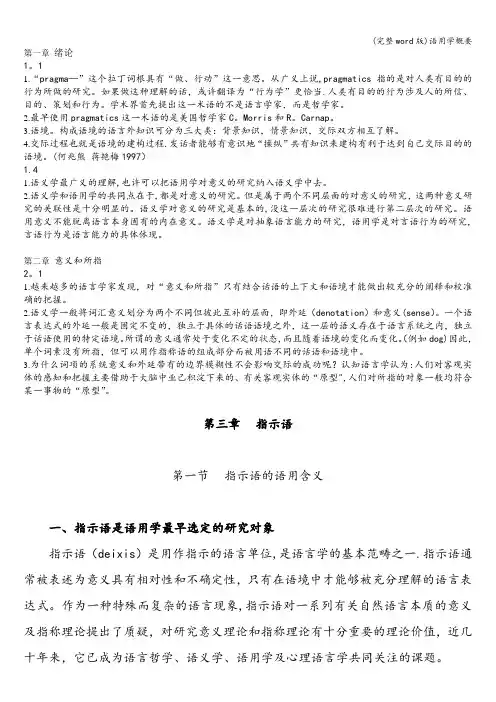
第一章绪论1。
11.“pragma—”这个拉丁词根具有“做、行动”这一意思。
从广义上说,pragmatics指的是对人类有目的的行为所做的研究。
如果做这种理解的话,或许翻译为“行为学”更恰当.人类有目的的行为涉及人的所信、目的、策划和行为。
学术界首先提出这一术语的不是语言学家,而是哲学家。
2.最早使用pragmatics这一术语的是美国哲学家C。
Morris和R。
Carnap。
3.语境。
构成语境的语言外知识可分为三大类:背景知识,情景知识,交际双方相互了解。
4.交际过程也就是语境的建构过程.发话者能够有意识地“操纵”共有知识来建构有利于达到自己交际目的的语境。
(何兆熊蒋艳梅1997)1.41.语义学最广义的理解,也许可以把语用学对意义的研究纳入语义学中去。
2.语义学和语用学的共同点在于,都是对意义的研究。
但是属于两个不同层面的对意义的研究,这两种意义研究的关联性是十分明显的。
语义学对意义的研究是基本的,没这一层次的研究很难进行第二层次的研究。
语用意义不能脱离语言本身固有的内在意义。
语义学是对抽象语言能力的研究,语用学是对言语行为的研究,言语行为是语言能力的具体体现。
第二章意义和所指2。
11.越来越多的语言学家发现,对“意义和所指”只有结合话语的上下文和语境才能做出较充分的阐释和校准确的把握。
2.语义学一般将词汇意义划分为两个不同但彼此互补的层面,即外延(denotation)和意义(sense)。
一个语言表达式的外延一般是固定不变的,独立于具体的话语语境之外,这一层的语义存在于语言系统之内,独立于话语使用的特定语境。
所谓的意义通常处于变化不定的状态,而且随着语境的变化而变化。
(例如dog)因此,单个词素没有所指,但可以用作指称语的组成部分而被用语不同的话语和语境中。
3.为什么词项的系统意义和外延带有的边界模糊性不会影响交际的成功呢?认知语言学认为:人们对客观实体的感知和把握主要借助于大脑中业已积淀下来的、有关客观实体的“原型",人们对所指的对象一般均符合某一事物的“原型”。
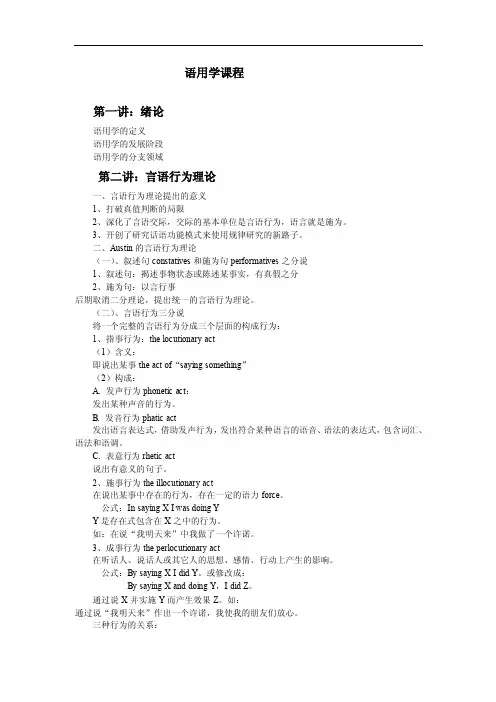
语用学课程第一讲:绪论语用学的定义语用学的发展阶段语用学的分支领域第二讲:言语行为理论一、言语行为理论提出的意义1、打破真值判断的局限2、深化了言语交际,交际的基本单位是言语行为,语言就是施为。
3、开创了研究话语功能模式来使用规律研究的新路子。
二、Austin的言语行为理论(一)、叙述句constatives和施为句performatives之分说1、叙述句:揭述事物状态或陈述某事实,有真假之分2、施为句:以言行事后期取消二分理论,提出统一的言语行为理论。
(二)、言语行为三分说将一个完整的言语行为分成三个层面的构成行为:1、指事行为:the locutionary act(1)含义:即说出某事the act of“saying something”(2)构成:A. 发声行为phonetic act:发出某种声音的行为。
B. 发音行为phatic act发出语言表达式,借助发声行为,发出符合某种语言的语音、语法的表达式,包含词汇、语法和语调。
C. 表意行为rhetic act说出有意义的句子。
2、施事行为the illocutionary act在说出某事中存在的行为,存在一定的语力force。
公式:In saying X I was doing YY是存在式包含在X之中的行为。
如:在说“我明天来”中我做了一个许诺。
3、成事行为the perlocutionary act在听话人、说话人或其它人的思想、感情、行动上产生的影响。
公式:By saying X I did Y。
或修改成:By saying X and doing Y,I did Z。
通过说X并实施Y而产生效果Z。
如:通过说“我明天来”作出一个许诺,我使我的朋友们放心。
三种行为的关系:是一个整体,施事行为实施的同时也包含了指事行为的完成。
评价:(三)施事行为的分类:1、裁决型:verdictives对事实或价值作出裁决,如:Convict assess,value diagnose analyse。

英语语用学是研究语言在特定情境下的使用方式以及其与意义之间关系的学科。
它涵盖了言语行为、礼貌原则、隐含意义等方面,以下是一些英语语用学的例子:1. **言语行为(Speech Acts):** 言语行为是指通过语言实现的行为,如请求、命令、承诺等。
例子:当一个人说 "Could you pass me the salt?"(你能把盐递给我吗?),这是一个请求言语行为。
2. **礼貌原则(Politeness Principles):** 礼貌原则涉及到在交流中如何尊重他人的感受和保持社交和谐。
例子:在请求时,可以使用更委婉的表达,比如 "Would you mind if I borrow your pen?"(你介意我借用你的笔吗?)。
3. **隐含意义(Implicature):** 隐含意义是指除了字面表达之外,通过上下文和说话人的语气,读者/听者可以理解的更深层次的信息。
例子:如果有人说 "It's a bit cold in here."(这里有点冷),可能暗示着对方希望调高室温。
4. **歧义(Ambiguity):** 歧义是一种一个句子有多种可能的解释的情况。
例子:"She saw the man with the telescope."(她用望远镜看到那个男人。
)这句话中,"with the telescope"可以解释为女人或者男人使用望远镜。
5. **指称(Reference):** 指称是指通过词语来引用特定的事物、人物或概念。
例子:"The cat is on the roof."(那只猫在屋顶上。
)这里的 "the cat" 指的是特定的猫。
6. **倒装句(Inversion):** 倒装句是语序颠倒的句子,用来强调、疑问或者其他语用目的。
语用学讲稿第四章第一篇:语用学讲稿第四章语用学讲稿第四章会话含义要点:A.在关于意义的学习里,Morris,Stevenson,Alston和Warnock都表明说要注重对用意、语境和意图的分析。
B.Grice的分析尤其的重要和有用。
因为他解释了意义和意图的概念之间的紧密联系。
C.意图对于一些有言外之意的指示和词语来说非常重要,但不是叙述人说的一切东西都有言外之意的。
D.Grice在关于含义的理论里很重要的一个观点是关于话的内容和话的含义的区别E.合作原则在人类所有的交流活动里都非常普遍的。
会话含义可以分为一般会话含义和特殊会话含义。
F.一般会话含义是指叙述人会遵守相应会话准则而且句子里会有某些相应的含义的。
特殊会话含义是指为了达到某些目的而使得对话违反了某些原则。
G.会话含义拥有可取消,不可分离,可推导,非规约,不确定的特性.1.意义和意图在语用学里,意义扮演着重要的角色,Grice发展过来的会话含义理论就是建立于对意义的分析的。
因此在介绍会话含义理论之前必须要先讨论一下意义。
1.1关于意义的观点意义所指理论认为所有的句子都有单词组成,而每一个单词都对应一个客体。
因此在这一点上,语言在现实世界是由实际的内容的。
但是这个理论还有很多需要改进的地方,因为它的解析有时候会使得句意缺失。
因此在关于意义的学习上,Morris,Stevenson,Alston和Warnock都表明说要注重对用意、语境和意图的分析。
Stevenson提出了意义的两种形式:描述性意义或者会话性意义和意识性意义和语用性意义。
而Grice的分析尤其的重要和有用,因为他指出了对话就是叙述者使其听者了解其说话意图的,并且解释了意义和意图的概念之间的紧密联系。
1.2 意义和意图的分析Grice指出他对意义的研究遵循以下规则:A通过X表达意思意味着A知道X的用途并使X意图显现出来从而使听众产生反应。
意图对于一些有言外之意的指示和词语来说非常重要,但不是叙述人说的一切东西都有言外之意的。
语用学课件整理稿(英文)What is pragmatics?Pragmatics is a systematic way of explaining language use in context [Context is generally considered as constituted by the knowledge [knowledge of the language they use, knowledge of what has been said before, knowledge about the world in general, knowledge about the specific situation in which linguistic communication is taking place, and knowledge about each other) shared by the speaker and the hearer.]It seeks to explain aspects of meaning which cannot be found in the plain sense of words or structures, as explained by semantics. As a field of language study, pragmatics is fairly new. Its origins lie in philosophy of language and the American philosophical school of pragmatism. As a discipline within language science, its roots lie in the work of (Herbert) Paul Grice on conversational implicature and the cooperative principle, and on the work of Stephen Levinson, Penelope Brown and Geoff Leech on politeness. Pragmatics is a subdiscipline of linguistics developed from different linguistics, philosophical and sociological traditions that studies the relationship between natural language expressions and their uses in specific situations. The term pragmatics comes from Morris? (1938) general theory of signs: in this semiotic model (semioti cs), pragmatics refers to the relationship of the sign to the sign user. The distinction between pragmatics and semantics, both of which investigate different aspects of linguistic meaning, is even less clear-cut. While semantics is concerned with the literal and contextually non-variable meaning of linguistic expressions or with the contextually non-variable side of the truth conditions of propositions or sentences, pragmatics dealswith the function of linguistic utterances and the propositions that are expressed by them, depending upon their use in specific situations (pragmatics concentrates on those aspects of meaning that cannot be predicated by linguistic knowledge alone and takes into account knowledge about the physical and social world).Distinction between pragmatics and semantics1. same:linguistic studies of meaning2. differenceSemantics is concerned with the literal and contextually non-variable meaning of linguistic expressions or with the contextually non-variable side of the truth conditions of propositions or sentencespragmatics deals with the function of linguistic utterances and the propositions that are expressed by them, depending upon their use in specific situations.Sentence meaning v. utterance meaningIf we take it as a grammatical unit and consider it as a self-contained unit in isolation, then we treat it as a sentence. Sentence means a unit of speech constructed according to language-dependent rules, which is relatively complete and independent in respect to content, grammatical structure, and intonation.If we take it as something a speaker utters in a certain situation with a certain purpose, then we are treating it as an utterance. Utterance means a string of sounds or written symbols produced by a speaker between two pauses. An utterance can consist of a single word or several sentences.Meaning of a sentence is abstract, and de-contextualized.Meaning of an utterance is concrete, and contextualized.Utterance is based on sentence meaning; it is the realization of the abstract meaning of a sentence in a real situation of communication, or simply in a context.Summary●Language meaning can be analyzed at several levels.●Semantics concentrates o n the meaning that comes from linguistic knowledge, whilepragmatics concentrates on those aspects of meaning that cannot be predicted by linguistic knowledge alone and takes into account our knowledge about the physical and social world.●The focus of pragmatics analysis is on the meaning of speakers? utterances rather thanon the meaning of words or sentences.Utterances need not consist of complete sentences. Each utterance is a unique physical event created at a particular point in time for a particular communicative purpose.What does pragmatics mainly include?The lack of a clear consensus appears in the way that no two published accounts list the same categories of pragmatics in quite the same order. But among the things you should know about are:DeixisSpeech actsPresupposition and entailmentCooperation and implicatureRelevancePoliteness principleDeixisDeixis:The way in which the reference of certain elements ina sentence is determined in relation to a specific speaker and addressee and a specific time and place of utterance.Deictic expressions(指示结构)include such lexemes as:Personal or possessive pronouns (所有格代名词)(I/you/mine/yours),Demonstrative pronouns (this/that),(Spatial/temporal) adverbs (here/there/now),Other pro-forms(替代词)(so/do),Personal or possessive adjectives (my/your),Demonstrative adjectives(指示形容词)(this/that) ,Articles (the).Pro-forms:(替代词)forms which can serve as replacements for different elements in a sentence.A: I hope you can come.B: I hope so.A: Mary is in London.B: John is there too.We invited Mary and John to eat with us because we liked them.A: I like coffee.B: We do too.Two kinds of usages of deixisGestural usage(手势型的用法): with the help of gestures, with some physical indication of the referent (e.g. direction of gaze), completely context-dependent.He is not the president. He is. He?s the secretary.Symbolic usage(象征型的用法): with the help of contexts (Gestures are not necessary.We should know the time, space, participants, etc. The communicators are not necessarily present.)This city is highly congested.Non-deictic usages of deixisEndophoric reference(文内照应): the entity(实体)the deixis refers to exists in the sentence/ passage, the purpose of the use of deixis is for cohesion(粘连). Mostly third person (single, plural) is used for endophoric reference.e.g.: Peter studies Japanese. He wishes to go to Japan some day.We were led into a big room. Here, it was said, Ford produced his first car.Exophoric reference(文外照应): the entity the deixis refers to does not exist, and the referential meaning can be judged from the context. Mostly first and second person (single, plural) is used for exophoric reference.e.g.: He?s not the president. He is. He?s the secretary.You can come with me if you like.Some deixis belongs neither to endophoric reference nor to exophoric reference, it doesn?t exist in a context or discourse(文篇), for example “we”, “you” which do not refer to specific persons; “here”, “there” used in some set expressions, e.g. “Here we are”,”There wego”.gestural usageexophoric referenceDeixis symbolic usageendophoric reference: cohensionCategories of Deixis2.3.1 Person DeixisDeixis depending on the identity of speakers, addressees, and others.1) The basic grammatical distinctions are the categories of first, second and third person ——speaker inclusion, addressee inclusion, speaker and addressee inclusion. [Some pronominal systems exhibit as many as fifteen basic pronouns (ignoring honorific alternates) by superimposing distinctions based on plurality, gender and so on.]2) The first and second person pronouns are usually used in exophoric reference; the third person pronouns (single and plural) are usually used in endophoric reference.e.g. You can come with me if you like.You can never tell what sex some teenagers are nowadays.John came in and he lit a fire.3) Third is quite unlike first and second person, in that it does not correspond to any specific participant-role in the speech event.4)Vocatives(呼语)can be divided into calls, or summonses(呼唤语)and addresses (称呼语). The distinction is precisely that between gestural and symbolic usages.Summonses are naturally untterance-initial, addresses are parenthetical and can occur in the sorts of locations that parentheticals can occupy.E.g Hey you, you just scratched my car with your Frisbee. (calls)The truth is, Madam, nothing is as good as nowadays. (addresses)4) It is common in many languages for mother to say to father, in the presence of little Billiesomething like “Can Billie have an ice-cream, Daddy?” taking the view, for the purpose of vocative selection, of the audience. These distinctions make it important that we do notconfuse the categories of addressee and hearer.5) In many languages, there are two first person “plural” pronouns corresponding to“we-inclusive-of addressee” (包括谈话对方)and “we-exclusive-of addressee”. (不包括谈话对方)E.g. Let us know the time of your arrival. (exclude the addressee)Let?s go to the cinema. (include the addre ssee)您安心养病吧!我们过几天再来看您。
●语用学●汉语言文学专业选修课●李军华●第一章绪论●语用学,也叫语言实用学或语言使用学,是语言学中新开拓的一个领域。
语用学主要研究语言的具体运用及其规律,尤其注重在不同的语言交际环境中如何理解和运用语言。
●今天星期天●妻子对丈夫说搞科研的劝告●赖床的提醒●孩子对父母说●GF对BF说邀请●职员对老板说拒绝●我去上课●学生说这句话时是“我去听课”的意思●教师说这句话时是“我去讲课”的意思●话语意思●话语意图●“语用”或“语用学”译自英语的pragmatics一词。
在当今大量的语言学研究的论文、专著和资料中,“语用”已是一个极为常见的专门术语了。
但把pragmatics译为“语用学”只是对这个词的狭义理解,只是把pragmatics这个词置于语言研究这个特定的范围里所作的理解。
“pragma-”这个拉丁词根具有“做、行动”这一意思。
●从广义上说,pragmatics指的是对人类有目的的行为所作的研究。
如果作这种理解的话,或许该把pragmatics译为“行为学”更加恰当。
●人类有目的的行为涉及人的所信、目的、筹划和行为●Green(1989:3)举了一个例子来说明这一点:救生员朝一个在水中挣扎的游泳者投去一个排球。
救生员的这—行为无疑是有意识、有目的的行为;这一行为基于救生员的一个意图,即救人,和至少三个所信:●(1)他相信游泳者需要救助●(2)他相信游泳者知道朝他投去的排球是用来救他的●(3)他相信游泳者知道怎样利用排球比水轻这一物理属性●在这三个所信中,第一个是有关游泳者的愿望的,第二和第三个所信是关于游泳者的所信。
救生员能否达到救人的目的显然和他本人和被救助者的所信有关。
●人类的语言交际也是一种有目的的行为,人类怎样通过语言交际来达到自己的目的和救生员怎样来达到自己救人的目的有共同的地方。
●把pragmatics用来指对有目的的语言活动的研究,是对这一词语的窄义理解,把它译为“语用学”自然是很合适的了。